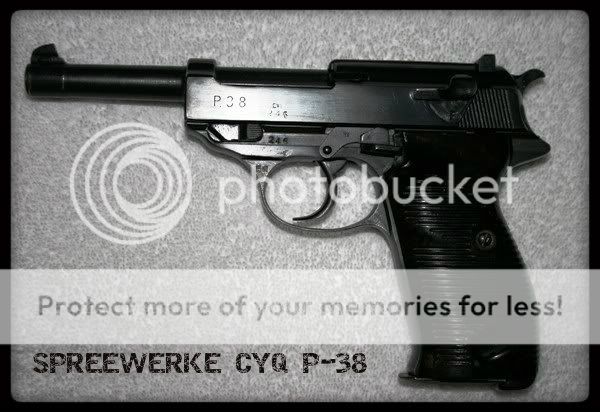S
SHOOTER13
Guest
Just wondering if anyone else on this forum collects military sidearms from WWI, WWII, the Korean conflict, or Vietnam War. Either Allied or Axis...Friend or Foe...or from any other combatant nation. I would like to see some pics and hear the story behind the weapon.
Pictured below is my P38 built by Spreewerke GmbH, Metallwarenfabrik, in Berlin/Spandau Germany in 1942 during the second World War. The Spreewerk inspection stamp consisted of an eagle above the number 88 (E/88), but the first 500 weapons made at the Spreewerke factory had Walther inspection stamps which consisted of an eagle over 359 (E/359) . (My specimen has a serial number of 246 and the Walther acceptance stamp E/359). The letters CYQ are the code used to designate construction at the Spreewerke plant, which produced around 285,000 units by the wars end. This specimen is also Wehrmacht stamped with an Nazi eagle over swaztika. The P38 is chambered for 9mm Parabellum and holds 8 rounds in the magazine. She also came with a black semi-hard leather holster that holds an extra magazine.

The P38 was the first DA/SA pistol adopted by a major power. When the hammer is forward, squeezing the trigger will cock the hammer--by means of a draw bar on the right side of the frame--and fire the first round much like a DA revolver. After that the hammer remains cocked, and subsequent shots are fired in SA mode.If the hammer is cocked, rotating the safety lever on the left rear of the slide downwards will lock the firing pin in place. As the lever reaches the bottom, it trips the sear, allowing the hammer to travel forward. The safety can be left down, which blocks movement of both the trigger and hammer, or moved up, allowing the first shot to be fired in DA mode. A pin located above the hammer acts as a loaded chamber indicator.
Pictured below is my P38 built by Spreewerke GmbH, Metallwarenfabrik, in Berlin/Spandau Germany in 1942 during the second World War. The Spreewerk inspection stamp consisted of an eagle above the number 88 (E/88), but the first 500 weapons made at the Spreewerke factory had Walther inspection stamps which consisted of an eagle over 359 (E/359) . (My specimen has a serial number of 246 and the Walther acceptance stamp E/359). The letters CYQ are the code used to designate construction at the Spreewerke plant, which produced around 285,000 units by the wars end. This specimen is also Wehrmacht stamped with an Nazi eagle over swaztika. The P38 is chambered for 9mm Parabellum and holds 8 rounds in the magazine. She also came with a black semi-hard leather holster that holds an extra magazine.
The P38 was the first DA/SA pistol adopted by a major power. When the hammer is forward, squeezing the trigger will cock the hammer--by means of a draw bar on the right side of the frame--and fire the first round much like a DA revolver. After that the hammer remains cocked, and subsequent shots are fired in SA mode.If the hammer is cocked, rotating the safety lever on the left rear of the slide downwards will lock the firing pin in place. As the lever reaches the bottom, it trips the sear, allowing the hammer to travel forward. The safety can be left down, which blocks movement of both the trigger and hammer, or moved up, allowing the first shot to be fired in DA mode. A pin located above the hammer acts as a loaded chamber indicator.

 Hilarious. Brilliant design, don't get me wrong. It's just funny that the average sig owner will laugh at the antiquated 1911 design, but their own pistol functions just like that Walther. Man. Nothing new under the sun!
Hilarious. Brilliant design, don't get me wrong. It's just funny that the average sig owner will laugh at the antiquated 1911 design, but their own pistol functions just like that Walther. Man. Nothing new under the sun!